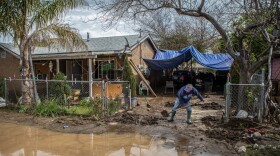Dangerous levels of radiation are leaking Tuesday from the earthquake-crippled Fukushima Daiichi nuclear power plant north of Tokyo and levels are rising, Japanese Chief Cabinet Secretary Yukio Edano said Tuesday.
Japanese Prime Minister Naoto Kan ordered everyone within 20 kilometers (about 12 miles) to evacuate. He told everyone within 30 kilometers (about 19 miles) to go inside. Japan's NHK television said most residents inside the 20-kilometer radius have already evacuated.
The Tokyo Electric Power Co., which operates the plant, said radiation levels outside the plant reached 8,200 microsieverts per hour at the front gate of the facility — more than three years of naturally occurring radioactivity in a single hour.
The No. 4 reactor at the power plant is on fire. An explosion rocked the No. 2 reactor Tuesday.
Unit 2 Reactor
Radiation levels at the unit 2 reactor rose at the time of the explosion and began to fall soon after. The elevated radiation levels after the blast have raised fears that the inner containment vessel holding the nuclear fuel has been damaged.
A spokesman for Japan's Nuclear and Industrial Safety Agency said the damage could be to the unit's suppression pool. The suppression pool, or torus, surrounds the nuclear reactor like a doughnut and is used only in emergencies to cool the core. If damage did occur, air or water could leak out depending on its location.
The pressure dropped inside the suppression pool after the explosion and the level of cooling water dropped. That exposed nearly 9 feet of nuclear rods — about half their length. The rods contain the radioactive fuel pellets that normally boil in a controlled manner to create steam to drive turbines for electricity. Once the rods are exposed, they quickly begin to melt down.
This explosion is very different from the first two at other reactors in the same facility. Those explosions — Unit No. 1 on Saturday and Unit No. 3 on Monday — were caused by hydrogen buildup as the result of emergency attempts to cool the reactor cores.
The latest blast compounds the crisis at the Fukushima plant. Earlier efforts to cool the No. 2 reactor with pumped-in seawater temporarily failed — leaving the nuclear fuel rods inside exposed and raising the risk that the rods had melted.
Keeping the nuclear fuel rods inside the core covered in water is crucial to preventing a meltdown, but the cooling systems for three separate reactors at the Daiichi plant have been failing since Friday's magnitude 9.0 earthquake and tsunami knocked out power at the facility. Twice Monday, officials said, water levels inside reactor No. 2 dropped enough to leave the fuel rods inside exposed above water.
The Japanese government has asked the International Atomic Energy Agency for experts to help with the situation, IAEA Director General Yukiya Amano said.
Meltdown Fears
Since Friday's earthquake, workers have been scrambling to address one crisis after another at the plant, and there are questions about their ability to keep the reactors and the radioactive material inside them under control.
Even as emergency crews on Monday focused on attending to the damage at the other two units, the cooling system at Unit No. 2 developed problems of its own.
Officials already suspected partial meltdowns at Daiichi's Unit No. 1 and Unit No. 3 reactors.
A partial meltdown isn't a technical term — it just means that the nuclear fuel rods that make up the reactor core have gotten so hot that they have started to melt.
If the fuel rods melt completely, it's considered a full meltdown, but that doesn't necessarily mean the radioactive materials have breached the containment structure and escaped.
Officials have not indicated that any of the three containment structures have been breached.
Meanwhile, workers are pumping seawater into all three troubled reactors in an attempt to cool the nuclear cores.
Source Of Blasts
Both blasts were blamed on explosive hydrogen gas coming from the reactor cores.
Hydrogen can be produced when a reactor's core overheats, damaging the zirconium tubes that hold the nuclear fuel.
"The fact that they had a hydrogen explosion tells you there was a lot more hydrogen available than there should have been," said Dale Klein, the former chairman of the Nuclear Regulatory Commission and an associate director of Energy Institute at the University of Texas, Austin.
"The hydrogen is usually generated when the zirconium cladding [on the fuel rods] interacts with steam and releases hydrogen," Klein told NPR.
If some of the rods are damaged and are falling apart, experts say the radioactive fuel pellets inside them could reach the bottom of the reactor vessel, where they would decay, heat up and melt further. Eventually, Klein says, a "molten mixture" could burn through the containment vessel.
"That containment would not survive very long and would result in a very large release of radioactivity, extremely hazardous and probably result in more evacuation," Klein said.
But Japanese officials have not detailed how many of the rods may be damaged at any of the reactors, and they may not be able to check.
International Response
The events at Fukushima have drawn increasing concern from the international community, including the IAEA, the U.N. nuclear watchdog.
"The Japanese authorities are working as hard as they can, under extremely difficult circumstances, to stabilize the nuclear power plants and ensure safety," IAEA chief Amano said in a statement to the agency's member states in Vienna.
The U.S. Agency for International Development has dispatched a team to Tokyo to provide technical assistance to the Japanese. Another government agency, the U.S. Nuclear Regulatory Commission, said it was considering sending its own experts as well.
The U.S Navy says 17 crew members from the USS Ronald Reagan aircraft carrier were exposed to a low-level radioactive plume during earthquake rescue operations. The Navy has a number of vessels in the ocean off the coast of Japan.
Copyright 2023 NPR. To see more, visit https://www.npr.org. 9(MDAzMjM2NDYzMDEyMzc1Njk5NjAxNzY3OQ001))






